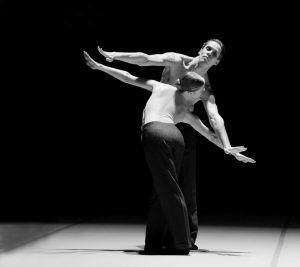Stuttgart Ballet: Goecke, Volpi, Cherkaoui / Stravinsky Today - Vancouver Ballet Society
- Home
- Reviews 2014 - 2019
- Stuttgart Ballet: Goecke, Volpi, Cherkaoui / Stravinsky Today

by Gary Smith
In the Stravinsky three-part program presented by Stuttgart Ballet in April, the dancers looked fluent in all three eccentric choreographic visions, but the sometimes dislocating movement didn’t always serve the music as well as less idiosyncratic productions.
That said, Germany’s Marco Goecke was at home finding a dark, driven side of Stravinsky’s score, The Song of the Nightingale, for his own piece of the same name, created for Leipzig Ballet in 2009. There were no romantic images here. Anything suggesting Hans Christian Andersen’s fairy tale about the brave little singing bird was expunged in favour of militaristic struts, quirky hand fluttering and physical tics. Bodies sometimes scrunched down, hands quivering in the air, feet pounding in a peculiar prance that suggested avian images of a darker destructive kind. Movement matched the beat of Stravinsky’s exciting score superbly. Occasional moments of lyric beauty offered contrast, as if flight released the dancers from earthly bonds.
Always there was a sense of darkness. Dancers appeared from an upstage abyss, later returning there to melt into blackness. Rain fell, cold and brutal, suggesting the hostility of some threatened rocky environment. Sometimes there was a silent scream, then gasping sounds. Dancers moved with hands locked, tugging their arms in wide circular sweeps that suggested hard flying against the wind.
Demis Volpi is a young Argentine-born choreographer who has created works that challenge our expectations of ballet. His 2013 piece, Krabat, for instance, is a satisfying, full-length work that adheres to storytelling, yet takes flight in new balletic directions. It was reasonable then to expect his Soldier’s Tale, given its premiere here, to be a work of power and invention. Unfortunately, the piece lacked focus, delivering coarse moments of comedy juxtaposed against sadness and loss.
A travelling troupe appeared with requisite theatre trunks ready to perform a show. They put on the ill-fitting costumes of a motley theatre band. Canons popped from steamer trunks painted in garish cartoon style. Before long it became apparent the choreography didn’t match the music. There was little passion or power. That may have been the intention, given this is a rag-tag troupe of players, but that doesn’t make what they did interesting.
The flaccid marching and stomping was dull. The female dancers began unpacking cardboard cutouts of household articles: cups, plates and teapots. We were weary of this long before they were finished and anyway, what was the point? It wasn’t until we got to the crux of the matter, and the young soldier (a handsome Martí Fernandez Paixa) sold his violin to the devil (a riveting Alicia Amatriain), that things began to heat up. By this point, though, it was too late.
In the ballet, the selling of the violin is an act of betrayal, a selling of the soul, a giving away of artistic freedom. It ought to be a powerful moment. It wasn’t. Well, at least not powerful enough. It’s not Amatriain’s fault. She danced her heart out. But what she was given to dance didn’t quite make us sit forward in fear and recognition. Still, it was a stunning performance by this dance actress who is one of the best of her time.
High hopes were pinned on Flemish-Moroccan Sidi Larbi Cherkaoui’s new re-imagining of The Firebird. And there were amazing moments in the ballet’s ebb and flow. There was, in fact, so much motion here you needed to distance yourself from its energetic whirl.
A whirlwind of arm wafting, large balletic steps and filmy material fluttering through space like clouds in a storm made this Firebird reminiscent of a 1940s Vincente Minnelli musical; the Damnation of Faust scene from The Band Wagon comes instantly to mind. Sections of a black pyramid-like structure opened and closed, whirling across the stage so the interior mirror portions reflected everything grander and larger than life. Dancers jetéd like popcorn. They strutted, bounced and generally created a flurry of motion, but to what end?
The pyramid, it seems, was meant to be an erupting volcano. At its first opening a gorgeous creature in red slid through a crack, like some spirit of the latest advertisement for Lubin perfume. The whole production, in fact, looked like an ad for something exotic from a Paris fashion house.
I just think Fokine did it better. When white chicken feathers rained down from the fly gallery — or was that meant to be volcanic ash? — I laughed, though. I loved the silliness of it all.
No one could fault the 16 dancers. They created dervish motion, and looked like a million bucks in Tim Van Steenbergen’s striking costumes.
DI SUMMER 2015

